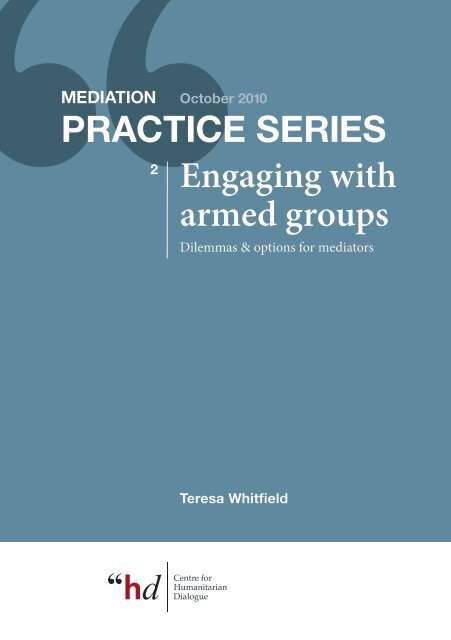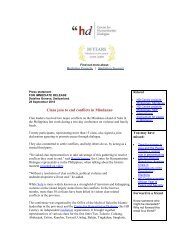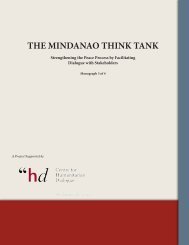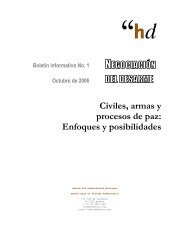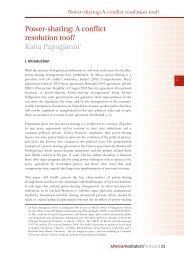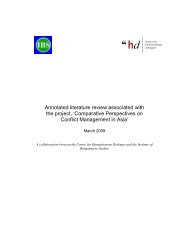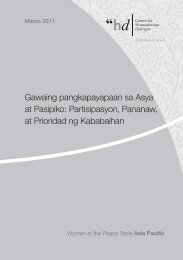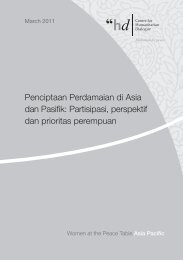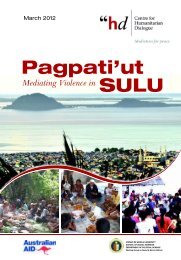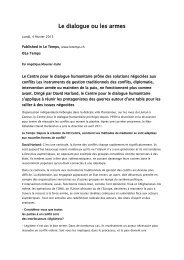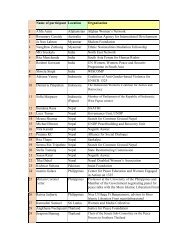Engaging with armed groups - Centre for Humanitarian Dialogue
Engaging with armed groups - Centre for Humanitarian Dialogue
Engaging with armed groups - Centre for Humanitarian Dialogue
- No tags were found...
Create successful ePaper yourself
Turn your PDF publications into a flip-book with our unique Google optimized e-Paper software.
The <strong>Centre</strong> <strong>for</strong> <strong>Humanitarian</strong><strong>Dialogue</strong> ( HD <strong>Centre</strong> ) is anindependent mediation organisationdedicated to helping improve theglobal response to <strong>armed</strong> conflict.It attempts to achieve this bymediating between warring partiesand providing support to thebroader mediation community.© Copyright Henry Dunant <strong>Centre</strong><strong>for</strong> <strong>Humanitarian</strong> <strong>Dialogue</strong>, 2010Reproduction of all or part of thispublication may be authorisedonly <strong>with</strong> written consent andacknowledgement of the source.The Mediation Practice Series is a project of the<strong>Centre</strong> <strong>for</strong> <strong>Humanitarian</strong> <strong>Dialogue</strong> (the HD <strong>Centre</strong>).We value the feedback of mediation practitionersand researchers on the <strong>for</strong>mat and content of thispublication. If you have any suggestions <strong>for</strong> improvement,please write to the editors, Luc Chounet-Cambas and Katia Papagianni, atmediationsupport@hdcentre.org
Mediation Practice SeriesAlthough these publications cannot replace practical experience,it is our hope that they can contribute to a more systematic learningprocess. The <strong>for</strong>thcoming publications in this series will bemade freely available on the HD <strong>Centre</strong>’s website and will bedisseminated through our network and those of our partners.Each publication is subject to a thorough peer review by practitionersand support staff <strong>with</strong> expertise in the relevant topics.<strong>Engaging</strong> <strong>with</strong> <strong>armed</strong> <strong>groups</strong> is the second publication in thisseries. The author would like to thank the three anonymous peerreviewers <strong>for</strong> their helpful observations and suggestions. Shewould also like to thank the following individuals, whose commentsand advice she drew on in the preparation of this paper : BarneyAfako, Hiruy Amanuel, Luc Chounet-Cambas, David Gorman,Romain Grandjean, Tom Gregg, Martin Griffiths, Priscilla Hayner,Nicholas Haysom, Theo Murphy, Katia Papagianni, David Petrasek,Jonathan Powell, Kieran Prendergast and Francesc Vendrell. Sheremains responsible <strong>for</strong> any errors the text may still contain.2
<strong>Engaging</strong> <strong>with</strong> <strong>armed</strong> <strong>groups</strong>Contents1. Introduction2. Why engage ?• Case study : The FMLN and the UN in El Salvador• Case study : Dilemmas of talking to the Taliban3. Engagement by whom?• Case study : Private mediators and the GAMin Aceh4. Identifying challenges and risks• Case study : Coping <strong>with</strong> pre-conditionson Hamas• Case study : The ICC and the LRA in conflictat the peace table• Case study : Norway and the LTTE5. Options• Case study : <strong>Engaging</strong> the Maoists in Nepal6. ConclusionsFurther reading57813141518202328293135383
<strong>Engaging</strong> <strong>with</strong> <strong>armed</strong> <strong>groups</strong><strong>Engaging</strong> <strong>with</strong><strong>armed</strong> <strong>groups</strong>Dilemmas & options <strong>for</strong> mediators1IntroductionAs mediators consider engagement <strong>with</strong> <strong>armed</strong> <strong>groups</strong> theyface a variety of challenges and options – including whether it iswise to engage at all. This contribution to the Mediation PracticeSeries addresses engagement by those working toward peaceprocesses which involve <strong>for</strong>mal interaction between leaders.The focus is on the dilemmas, challenges and risks involved in amediator’s early contacts <strong>with</strong> an <strong>armed</strong> group and subsequentengagement as interlocutor, message-carrier, adviser and/orfacilitator – all roles that may precede and accompany <strong>for</strong>malnegotiation between parties to a conflict. 1The <strong>armed</strong> <strong>groups</strong> considered are those whose rebellion orresistance explicitly challenges the authority of the state, ratherthan the full spectrum of non-state <strong>armed</strong> <strong>groups</strong> (which wouldinclude criminal organisations and gangs, as well as paramilitaryactors accountable to the state). The <strong>for</strong>mer claim their violenceis rooted in legitimate self-defence against the infringement oftheir rights. Political in its origin – if at times criminal in its conduct– <strong>armed</strong> action is pursued as a means to a political end. Whilemilitary pressure, or other actions by security <strong>for</strong>ces, may be5
Mediation Practice Seriesnecessary to counter it, in almost all cases a lasting resolution tothe conflict will depend on some <strong>for</strong>m of political accommodationor agreement.Even <strong>with</strong>in this definition, <strong>armed</strong> <strong>groups</strong> are characterised bytheir great diversity as well as the varied degree of threat whichthey represent to the state. Rebel <strong>for</strong>ces organised as an armyand capable of holding territory (the Sudan People’s LiberationArmy or the People’s Liberation Army in Nepal) are distinct frombroad political-military resistance movements such as Hamas andHezbollah (the <strong>for</strong>mer, of course, has controlled Gaza since it wonelections in 2006). Different again are smaller <strong>groups</strong>, such as theIrish Republican Army (IRA), or the Basque separatist group ETA,organised in cell structures to facilitate the planning of targetedacts of violence but <strong>with</strong> links to political surrogates ; the broadrange of ethnic-based <strong>armed</strong> <strong>groups</strong> in Africa and Asia strugglingto assert control over populations, territory and/or resources ; orinterlinked <strong>groups</strong> such as Islamist militants active in Somalia andYemen, Afghanistan and Pakistan, in some instances <strong>with</strong> ties tothe international network of Al Qæda.Such diversity accentuates the need to be wary of oversimplificationor of relying too easily on general principles. Withthis in mind, the following five sections address the arguments<strong>for</strong> engagement <strong>with</strong> <strong>armed</strong> <strong>groups</strong>. They consider the questionof who should engage, the challenges and risks involved, andthe options available to mediators, be<strong>for</strong>e offering some briefconclusions. All acknowledge that the issue of engaging <strong>with</strong> aspecific group will almost certainly turn on the particularities ofthat group, the nature of its insurgency and the context in whichit operates. 26
The FMLN andthe UN in El SalvadorIn November 1989 the largest offensive of the civil war betweenthe broadly Marxist-Leninist Farabundo Martí National LiberationFront (FMLN) and the Government of El Salvador revealeda military stalemate that <strong>for</strong>ced the parties into UN-mediatednegotiations. These were facilitated by earlier contacts the UN hadestablished <strong>with</strong> the FMLN through a highly capable individualwho represented the organisation on human rights issues. Heencouraged discussion <strong>with</strong> FMLN commanders in the margins ofa meeting of the non-aligned movement held in Harare in 1988. Infurther consultations UN officials offered assurances to the FMLNof the Secretary-General’s impartiality as a mediator, and distinctionfrom the UN Security Council.The United States did not question the UN’s contacts <strong>with</strong> theFMLN but subsequently raised concern that the mediator, Alvarode Soto, was partial to it. He countered by encouraging the US tomeet <strong>with</strong> the FMLN itself. In time it did. A US Congressman andthe US Ambassador travelled to a guerrilla camp <strong>with</strong>in El Salvadorbe<strong>for</strong>e the conflict’s end, and the US Ambassador to the UNquietly attended a meeting <strong>with</strong> the FMLN’s General Commandduring the final stages of negotiations held in New York in late1991. The US put important pressure on the Salvadoran Governmentto accept the peace agreement and became a firm supporterof its implementation.8
<strong>Engaging</strong> <strong>with</strong> <strong>armed</strong> <strong>groups</strong>of their ef<strong>for</strong>ts to quash them. The question of engagement grewmore controversial, even as globalisation and a ready access tothe media ensured that, at an operational level, <strong>armed</strong> <strong>groups</strong> andtheir representatives have never been easier to find or contact.Arguments <strong>for</strong> engagement today are rooted in principle andpragmatism. They can be broadly summarised as follows :• The persistence of <strong>armed</strong> conflict and a belief that engaging<strong>armed</strong> <strong>groups</strong> is the preferred means to bring it to anend, not least because military options against insurgentson their own rarely succeed in creating conditions that willfoster sustainable peace. 3 Despite an overall trend toward areduction of violence since the end of the Cold War, therewere 36 active <strong>armed</strong> conflicts in 2009, all of them involvingthe state and one or more non-state <strong>armed</strong> <strong>groups</strong> – a rise ofnearly one quarter since the early 2000s. 4• The imperative to protect local populations from continuingviolence. Even in circumstances in which engagementmay not lead to a resolution, it can address human rights andother humanitarian concerns, secure a presence in a conflictzone to monitor humanitarian conditions, and save lives.• The need to ensure that those <strong>armed</strong> actors (or their representatives)who have had primary roles in pursuing the conflictand have the capacity to reach – or undermine – agreementsthat will facilitate its end, are included in processes towardspeace and are present at the peace table. Armed <strong>groups</strong> mayrepresent sizeable constituencies ; when they have grievances,and the ability to sustain <strong>armed</strong> action, they will have the abilityto spoil any settlement from which they are left out.• An opportunity to develop a channel of communication toan <strong>armed</strong> group. This has various benefits, even in circumstancesin which a peace process seems remote. A channelmay prove useful to defuse a crisis or emergency, or address9
Mediation Practice Series“You can talk to terrorists,but you don’t have to agree<strong>with</strong> them.”Jonathan Powell, <strong>for</strong>mer Chief of Staffto UK Prime Minister Tony Blairan issue such as a kidnapping, <strong>with</strong> discretion. If maintainedby a third party rather than a government it also offers thepossibility of deniability. Over time such a channel might beactivated <strong>for</strong> the pre-negotiation of terms <strong>for</strong> meetings betweenthe parties.• A means to acquire greater understanding of the <strong>armed</strong>group and its motives and capacities <strong>for</strong> engagement. Greaterunderstanding will provide the basis <strong>for</strong> analysis of thechallenges and risks specific to engagement <strong>with</strong> eachparticular group. It may also allow the mediator to identify thegroup’s interests – as opposed to its public plat<strong>for</strong>ms – and thusthe issues on which the group and government might findcommon ground.• The opportunity to build trust <strong>with</strong> the <strong>armed</strong> group. Themediator may be able to encourage the group to reflect onentrenched positions and/or prevent its immersion in a logicthat is a consequence of its isolation and pursuit of <strong>armed</strong>struggle. Such trust may allow themediator to build an <strong>armed</strong> group’scapacity <strong>for</strong> negotiation, both inadvance of, and in parallel to, peacetalks – something that even governmentswill admit can contribute to thequality of any resulting agreement.Yet engagement is not easy. There may be “no such thing as abad conversation”, as was observed <strong>with</strong>in a 2009 workshop heldat the U.S. Institute of Peace on the subject of mediation <strong>with</strong>proscribed <strong>groups</strong>. 5 However, any conversation <strong>with</strong> an <strong>armed</strong>group is laden <strong>with</strong> implications. Reasons not to engage there<strong>for</strong>ecannot be dismissed lightly. 6 Different potential mediators willhave different legal and political red lines, but the most commonarguments against engagement revolve around the following :10
<strong>Engaging</strong> <strong>with</strong> <strong>armed</strong> <strong>groups</strong>• That no <strong>for</strong>m of engagement will have an impact upon thebehaviour of a group that is bent on violence and determinedto maintain positions of implacable hostility to its enemies. Thisis a proposition that requires serious consideration. However,engagement need not constitute appeasement. There is noneed to agree <strong>with</strong> an <strong>armed</strong> group and there are other benefitsto be gained from exploratory contacts.• That any <strong>for</strong>m of engagement <strong>with</strong> those who use violenceto challenge state power risks strengthening them andwill enhance their legitimacy <strong>with</strong> their own constituentsand on the international stage. This line of thinking receivedrein<strong>for</strong>cement in a June 2010 ruling of the U.S. Supreme Courtwhich upheld the constitutionality of a federal law that makesit a crime to provide “material support” – defined to include“expert advice or assistance”, “training” and “services” andembracing the advocacy <strong>for</strong> human rights or peace – to thoseidentified as <strong>for</strong>eign terrorist <strong>groups</strong>. 7• Conversely, that democratic governments may face heatedopposition to their engagement <strong>with</strong> <strong>armed</strong> <strong>groups</strong>,whether through proxies or directly. It is difficult <strong>for</strong> governmentsto justify talks <strong>with</strong> those who are killing their citizens.It is also embarrassing, or worse, if the existence of talksemerges after a government has denied them. A governmentwill not want to be perceived to be rewarding an <strong>armed</strong> group<strong>for</strong> its past violence, or give it perverse incentives <strong>for</strong> carryingon killing.• That war is a better solution. A number of governmentshave drawn encouragement from what has been termed the“Sri Lanka option” : a tough military response, the refusal tocountenance a political solution, and instead a consciousdecision to wage war to destroy an <strong>armed</strong> group. As theInternational Crisis Group has argued, the model sets adangerous precedent, not only <strong>for</strong> its violation of the mostbasic laws of war, but also <strong>for</strong> its failure to address most11
Dilemmas oftalking to the TalibanBy mid-2010, talking about talking to the Taliban had becomecommonplace as doubts about the success of US-led counterinsurgencyef<strong>for</strong>ts mounted. But differences regarding what shouldbe talked about, who should do the talking, how it should relate tothe military logic of international engagement in Afghanistan and abroader process of regional reconciliation, remained rife. Since late2001, when the Taliban were driven from power and established asafe-haven in Pakistan, they had neither been engaged in <strong>for</strong>malpolitical terms nor developed a coherent set of political demands.Yet individual contacts from the Afghan Government and by othersincluding representatives of Saudi Arabia, the UN, the ICRC andNGOs (in addition to Pakistan) had multiplied.Challenges to the initiation of a political process stem from a lackof consensus on its objective. Persistent corruption continues to bea source of conflict. Distrust and differences on policy are present<strong>with</strong>in, and between, the Afghan Government, the Taliban, theUnited States, and critical regional actors such as Pakistan, India,Iran, Saudi Arabia and Russia. Issues that divide them include :opposition to engagement <strong>with</strong> the Taliban by non-PashtunAfghans ; a combination of intensified military pressure from theUS and wavering support of its NATO allies, affecting the Taliban’scalculations of when to engage and how seriously ; the continuingpresence of Taliban leaders on the UN sanctions list ; Pakistan’srole ; and the whole question of pre-conditions. The Taliban wantsanctions lists lifted, prisoners released and Western troops out ;the US and Saudi Arabia insist that the Taliban should break all tiesto Al Qæda. These issues could conceivably be addressed <strong>with</strong>innegotiations, but not in advance of them.The situation calls <strong>for</strong> a graduated approach to sustained engagement<strong>with</strong> the Taliban and other insurgent <strong>groups</strong>, if not by theUS then by others trusted by the US, the Afghan Government andthe Taliban. In the absence of clarity on a desired end state <strong>for</strong>Afghanistan (or the process to reach it) more limited goals couldinclude improved understanding of the Taliban and deepeningengagement on humanitarian issues.13
Mediation Practice Seriesinternational exposure as well as expertise become moreamenable to pursuing its goals by peaceful means – will only beascertained in the course of an engagement. 9The complexity of these issues demands a clear-eyed assessmentof the mediator’s own capacity and comparative advantages ;careful analysis of the <strong>armed</strong> group (including its motives in contemplatingengagement <strong>with</strong> an external actor) ; the challengesand risks involved in engaging it ; and a detailed understandingof the varied options to do so. As Afghanistan demonstrates, theoptions be<strong>for</strong>e a potential mediator may be limited.3Engagement by whom ?The United Nations, regional organisations, individual statesand private mediators engage <strong>with</strong> rebel and resistance <strong>groups</strong><strong>with</strong> different capacities, visibility and leverage. 10 Their work maycomplement the channels that governments themselves maintainto <strong>armed</strong> <strong>groups</strong> they publicly hold to be pariahs (as was the caseof the UK Government and the IRA). In other cases either no suchchannels exist, or domestic political sensitivities regarding “talkingto terrorists” prohibit their utilisation <strong>for</strong> substantive or sustainedengagement. In these cases, third party intermediaries will berequired to establish contact between two or more parties andhelp explore whether conditions <strong>for</strong> a negotiation exist.The asymmetry of conflict involving a government and one ofmore non-state <strong>armed</strong> <strong>groups</strong> as well as a state-centric internationalsystem have an impact on questions of which mediatorsmay be best placed to engage <strong>with</strong> amed <strong>groups</strong>. This is particularlyevident in the early stages of a process. The proliferationof terrorist lists maintained by individual states and multilateralorganisations represents one set of constraints <strong>for</strong> engagement(this is not to deny positive impacts in some cases, includingthe pressure under which <strong>armed</strong> <strong>groups</strong> have been placed14
Private mediatorsand the GAM in AcehThe HD <strong>Centre</strong>’s involvement in Aceh dated back to late 1999 andits early focus on the prevention of humanitarian crises in theprovince. It conducted initial meetings <strong>with</strong> representatives ofthe Free Aceh Movement (GAM) in Malaysia and Sweden, whileconsulting key stakeholders in Jakarta and Aceh. The GAM wasreluctant to meet face-to-face <strong>with</strong> representatives of the Governmentof Indonesia, but a first meeting eventually took place inearly 2000 (The GAM was assured by the HD <strong>Centre</strong> that it wasnot <strong>for</strong>mally “talking” to the Government, but just discussinghumanitarian issues). The ensuing negotiations broke down fivemonths after the signing of a Cessation of Hostilities Agreement(COHA) in December 2002, but had contributed to substantiveshifts on the part of the GAM. Perhaps none was more significantthan the GAM’s recognition of the Government of Indonesia andacceptance that autonomy could be implemented in the COHA.The GAM had welcomed the legitimacy which internationalinvolvement in its peace process, through the HD <strong>Centre</strong>, offered(even as the Indonesian Government had accepted the HD <strong>Centre</strong>only because its private status minimised the same legitimacy).However, it never hid its interest in a more high profile facilitator.The second engagement on Aceh was given impetus bothby Indonesia’s first direct elections <strong>for</strong> president in 2004, andthe devastating tsunami that struck that December. Facilitatedby Martti Ahtisaari and the Crisis Management Initiative, talksheld in Helsinki began in early 2005. The GAM welcomed bothAhtisaari, as a <strong>for</strong>mer President of Finland, and the access to theEuropean Union he brought to the process. Upon Ahtisaari’srecommendation, it also accepted capacity-building fromSwitzerland. In these circumstances, the GAM dropped itsdemand <strong>for</strong> Acehnese independence, perhaps the critical elementin allowing a peace agreement to be concluded in August 2005.15
Mediation Practice Seriesto abandon the military struggle). The lists impose no uni<strong>for</strong>mlimit on contacts <strong>with</strong> listed <strong>groups</strong> or individuals. However, asis discussed below, US citizens or those who come under USjurisdiction (including non-US nationals) may be prosecuted ifthey provide funds or other “material support” – which can be“Different kinds ofmediation suggest differentkinds of institutions ;some require the resourcesand leverage that onlygovernments or multilateralinstitutionscan bring to bear, whilein others powerlessnesscan be an asset, a basis<strong>for</strong> confidence and trustbuilding.”Nicholas Haysom, Executive Office of theUN Secretary-Generalconstrued to include mediation – to<strong>groups</strong> identified by the US Governmentas terrorist. Meanwhile, eventhose mediators who do not fearprosecution may find the questionof their engagement <strong>with</strong> an <strong>armed</strong>group inhibited by the existenceand incoherence of the proscriptionregimes. 11States, and multilateral bodies composedof states, have a bias towardspower and in-built sympathies towardsother states that long pre-date theexistence of terrorist lists. They tendto assume that use of <strong>for</strong>ce by a nonstateactor is illegitimate (particularlyif, like India or Russia, they have activeconflicts <strong>with</strong>in their borders). They willunderstand that many governmentswill refuse to engage directly <strong>with</strong>insurgent <strong>groups</strong> unless the latter first agree either to abandonthe <strong>armed</strong> struggle, or at least to a cessation of hostilities.Non-state <strong>armed</strong> actors, meanwhile, struggle to gain access tothe <strong>for</strong>a in which their conflicts will be discussed (such as theUN Security Council) and differ widely in their familiarity <strong>with</strong>the norms and practices of international diplomacy.As a variety of mediators may be involved in a given peaceprocess over a number of years, this places emphasis onthe importance of sequencing. Different mediators will havedifferent advantages at different stages of a peace process.16
<strong>Engaging</strong> <strong>with</strong> <strong>armed</strong> <strong>groups</strong>Similarly, questions of precedent and concerns about terrorismcarry widely differing weight in different political contexts.• United Nations : The UN Secretary-General and SecurityCouncil have different roles and responsibilities <strong>with</strong> regard topeacemaking. The UN Secretary-General engages in mediationand “good offices” whose legitimacy and impartiality arerooted in the UN Charter. These characteristics contribute tothe fact that UN mediation remains attractive to many <strong>armed</strong><strong>groups</strong> (others will question a Secretary-General’s ability toact independently of powerful states on the Security Council).State actors may shy away from the UN out of concern<strong>for</strong> issues of sovereignty and/or the difficulties inherent ininvolving the UN in a confidential process. In a case such asNepal, however, discreet political work enabled UN officials toengage early <strong>with</strong> an insurgent group. In other circumstances,such as the eastern Democratic Republic of Congo, they havebeen called upon to facilitate complex talks between statesand a variety of <strong>armed</strong> <strong>groups</strong>.• Regional organisations : Regional and sub-regional organisationshave the advantages of proximity to the conflict aswell as knowledge of, and sometimes leverage over, conflictparties. However, their engagements may be subject to pressurefrom their larger member states ; limited by issues of mandateand/or capacity ; or distorted by the sponsorship of some<strong>armed</strong> <strong>groups</strong> by one, or more, oftheir members (sponsorship of an<strong>armed</strong> group by a neighbouringstate is all too common and canrender that group a tool of the<strong>for</strong>eign policy of its patron, andthus a <strong>for</strong>ce <strong>for</strong> regional, as well aslocal, instability).States, and multilateralbodies composed of states,have a bias towardspower and sympathiestowards other states thatpre-date the existence ofterrorist lists.17
Mediation Practice Series• Individual states : Individual state mediators – from the UnitedStates to prominent regional actors such as Nigeria, SouthAfrica, India, Indonesia, Malaysia, Saudi Arabia, Turkey andQatar – are able to wield relative power and influence overconflict parties. However, their own interests in a conflict’soutcome, or concerns <strong>with</strong> the issue of terrorism, may inhibittheir engagement <strong>with</strong> <strong>armed</strong> <strong>groups</strong>. In Europe, peacemakinghas flourished in two states – Norway and Switzerland – thatare not members of the European Union and are there<strong>for</strong>e notconditioned by its listing of terrorist entities.• Private mediators : Independent international mediatorsinclude both private organisations and prestigious individuals.Although “weak” mediators, to the extent that they have toborrow leverage from others, private mediators engage <strong>with</strong><strong>armed</strong> <strong>groups</strong> <strong>with</strong> particular advantages. They are small,flexible and independent, and can engage early (and <strong>with</strong>discretion) <strong>with</strong> <strong>groups</strong> others might consider pariahs, or notyet meriting attention. Their involvement is inherently less threateningto a government than that of an official actor, and carries<strong>with</strong> it the important attribute of deniability. However, they canalso be dismissed from a process <strong>with</strong> no great political costand will need to link up to official actors as mediation advances.4Identifying challenges and risksFor a mediator or facilitator decisions regarding whether, and how,to engage will be rooted in detailed analysis of the <strong>armed</strong> group aswell as the broader context <strong>with</strong>in which it is active. Is the struggleto take part in (or take over) the national government, secession,or <strong>for</strong> control of territory and resources <strong>with</strong>in existing borders ? Isthe composition of the group determined by ethnicity, or in religiousterms ? To what extent are structures of command and controlidentifiable and accessible ? (In some cases, as in Aceh, this mayinvolve relations between field commanders and a more distant,18
<strong>Engaging</strong> <strong>with</strong> <strong>armed</strong> <strong>groups</strong>perhaps even exiled, leadership). Does the mediator understanda group’s constituency and support base, the role played bywomen <strong>with</strong>in the <strong>armed</strong> group, and its economic sustenance and/or interaction <strong>with</strong> the diaspora ? (This is a critical issue in contextsas diverse as Somalia and Sri Lanka). What are the group’srelations to other actors (sustainers and spoilers) active inside theconflict system and beyond it ? Is there an outside state or statessupporting/controlling the <strong>armed</strong> group ? Particular attention willneed to be paid to the strategic choices the group may be facing.Where does <strong>armed</strong> action fit in to a group’s broader goals ? Whatcalculations will be involved in abandoning the military aspects ofits struggle ? What costs will it incur by engaging in talks ?Among the numerous issues that are likely to present themselvesas challenges, the following stand out :• Interlocutors and decision-making : A mediator’s task willbe greatly facilitated if his or her prospective interlocutor is aneffective <strong>armed</strong> group, <strong>with</strong> good command and control andclear procedures of political decision-making (as the FMLN inEl Salvador) or a charismatic leader <strong>with</strong> recognised authority(such as John Garang of the Sudanese People’s LiberationArmy, or indeed Gerry Adams of Sinn Fein). However, thiswill frequently not be the case. Amediator should there<strong>for</strong>e considerif he or she is able to develop anunderstanding of decision-makingprocesses <strong>with</strong>in the <strong>armed</strong> groupand the extent to which interlocutorsare legitimate representativesof its leadership. Do those at theDo those at the negotiationtable have authority, or atleast report directly to whosewho do ?negotiating table have authority, or at least report directlyto those who do ? (This was a concern regarding the Lord’sResistance Army team present at the negotiations in Juba,<strong>for</strong> example).19
Coping <strong>with</strong> preconditionson HamasHamas’ decision to take part in legislative elections <strong>for</strong> the PalestinianAuthority in early 2006 represented a historic shift as wellas an end to its suicide bombing campaign. Its victory took theWest by surprise and initiated a period of economic and politicalisolation – intensified by Israel’s blockade of the Gaza strip afterthe collapse of the unity Government in June 2007 – that has haddisastrous economic and humanitarian consequences and jeopardisedef<strong>for</strong>ts towards peace.The Quartet of the European Union, Russia, the UN and the USconditioned future assistance to a Palestinian Government uponthat Government’s “commitment to the principles of nonviolence,recognition of Israel, and acceptance of previous agreements andobligations”. 12 These conditions were unacceptable to Hamas. TheQuartet introduced no explicit pre-conditions on contacts <strong>with</strong>Hamas (and Russia has always maintained them), but both theUS and the EU list Hamas as a terrorist group. While the EU listdoes not proscribe contacts (only funding), after Hamas’ electoralvictory in 2006 the European Council took the political decisionto isolate Hamas further by cutting contact <strong>with</strong> it. In deferenceto pressure from the US, and in stark contrast to a traditionaldisposition to engage <strong>with</strong> any party deemed necessary <strong>for</strong> peace,the UN Secretary-General restricted political contact by the UNSpecial Coordinator <strong>for</strong> the Middle East Peace Process <strong>with</strong> Hamas.However, contact was allowed at the working level.Since 2006, engagement <strong>with</strong> Hamas has remained in limbo.The Quartet position – and that of the United States <strong>with</strong>in it –is unchanged (and Hamas is still there). A variety of mediatorsand/or would be mediators from the West – including Norwayand Switzerland, <strong>for</strong>mer diplomats and NGOs – have pursuedcontact and opened channels to Hamas’ leadership in Gaza andDamascus. Regional mediators, including both Turkey and Egypt,remain involved. Yet while the red lines of the major internationalplayers still hold, and <strong>with</strong>out effective channels back to theUnited States and/or Israel, <strong>for</strong>ward movement remains a distantprospect.20
<strong>Engaging</strong> <strong>with</strong> <strong>armed</strong> <strong>groups</strong>• Fragmentation : Fragmented <strong>groups</strong>, those <strong>groups</strong> <strong>with</strong>outa recognised leader or command structure, present obviouschallenges, not least because – as in the case of the multiplerebel movements in Darfur – one group may claim greaterlegitimacy than others and seek to veto participation.Fragmentation complicates the issue of regular access bythe mediator as well as decision-making, and can invalidatethe prospect of a ceasefire. Unsuccessful attempts to unifythe <strong>groups</strong> in Darfur point to a need <strong>for</strong> alternative processes(such as the 2010 initiative to engage civil society) anda unification ef<strong>for</strong>t that combines support from a major power<strong>with</strong> detailed contextual knowledge of the various movements’internal dynamics.• State actor attitudes : Deciding when, and where, to in<strong>for</strong>ma government of early engagement <strong>with</strong> an <strong>armed</strong> group <strong>with</strong>inits territory will be a delicate matter (except in circumstances,such as the UN found in Colombia from 1999 – 2002, whenengagement <strong>with</strong> rebel <strong>groups</strong> is directly solicited by theGovernment). Are there other states (neighbours or regionalpowers) whose consent or support <strong>for</strong> engagement will berequired ? (As Norway secured from India during its involvementin Sri Lanka). If so, at what point to in<strong>for</strong>m them and how ?In cases <strong>with</strong> a particularly weak state actor – such as theTransitional Federal Government in Somalia – concerns aboutits fragility impact directly upon decisions regarding whether toengage <strong>with</strong> the <strong>armed</strong> resistance (Al Shabaab in this instance).• Gaining trust : Winning the trust of an <strong>armed</strong> group may bea slow and difficult process, but is an essential element of athird party’s involvement. Broad cultural and/or religious differencesbetween the mediator and the <strong>armed</strong> group mayconstitute particular challenges. Anti-terrorist rhetoric, the perceivedhostility of the West toward Islam, the invasion of Iraqand continuing conflict in the Middle East all, <strong>for</strong> example,may hinder engagement <strong>with</strong> Islamist <strong>groups</strong> by Westernmediators conditioned – or perceived to be conditioned - by a21
Mediation Practice Seriessecular and internationalist approach. (The peace jirga held inAfghanistan in June 2010 concluded <strong>with</strong> a call <strong>for</strong> help fromMuslim countries, including Saudi Arabia and Turkey).• Pre-conditions : Rigid pre-conditions may not be an obstaclein the early phases of engagement (pre-negotiation), but willbecome so as parties move into “talks about talks”. Frequentlysuch conditions – whether they are <strong>for</strong> an end to violence,a ceasefire, recognition of an occupying power, or therenouncing of secessionist goals – touch upon either the<strong>armed</strong> group’s primary source of leverage upon the process(its arms), or the core issue in contention. It should not surprisea potential mediator, or the <strong>armed</strong> group’s adversary, that thegroup in question will not be prepared to concede such issuesat the beginning of a process.• Absence of a clear or “realistic” agenda : A lack of clarityon what is wanted from a political process by the <strong>armed</strong> group,or the reiteration of maximalist but “impossible” goals (such asAl Qæda’s demands <strong>for</strong> the establishment of a new caliphate)both present obstacles to negotiations. Such obstacles neednot necessarily preclude other <strong>for</strong>ms“You can negotiate<strong>with</strong> someone who has apolitical agenda. The LRAdoes not have one.”Salva Kiir, First-Vice President of Sudan,President of the Government of SouthernSudan 13of engagement that might help shiftan <strong>armed</strong> group’s positions, or reachout to affiliates of the group in question<strong>with</strong> more localised concerns(such as Al Shabaab). However, inpractice, the perception that there is“nothing to talk about” <strong>with</strong> an <strong>armed</strong>group represents one of the mostfrequent deterrents to engagement.• Competition : The presence, or interest, of other potentialmediators can complicate engagement <strong>with</strong> an <strong>armed</strong> groupand overcrowd the mediation. In some cases – such as Darfurat different moments – it has not been just the rebels who dothe “<strong>for</strong>um shopping”. There have been external actors, some22
The ICC and theLRA in conflict at thepeace tableFor many years the international community neglected the conflictbetween the Lord’s Resistance Army (LRA), led by the enigmaticJoseph Kony, and the Government of Uganda <strong>with</strong> devastatingconsequences <strong>for</strong> the people of Northern Uganda. Peacemakingwas pursued by the Ugandan politician Betty Bigombe, whoreceived discreet support from the UN and a number of states. Heref<strong>for</strong>ts ended in early 2005. By then, at the request of the UgandanGovernment, the International Criminal Court had initiated aninvestigation into the situation. In July 2005, ICC judges issuedsealed warrants <strong>for</strong> the arrest of Kony and four LRA commanders.They were unveiled in October that year.A new peace process began in mid-2006 in Juba, at the instigationof the Government of Southern Sudan, facilitated by its Vice-President, Riek Machar, and actively supported by UN envoy,<strong>for</strong>mer President Joachim Chissano of Mozambique. This processrepresented a confrontation between two different <strong>for</strong>ms ofengagement <strong>with</strong> an <strong>armed</strong> group : one driven by peace and theother by justice. The parties reached agreement on the text of acomprehensive peace agreement, but the ICC arrest warrants hungheavily over them as Kony, and the other indicted commanders,refused to attend <strong>for</strong>mal talks in Juba. The LRA was insteadrepresented by exiled Acholi in the diaspora and others whoseability to speak <strong>for</strong> Kony was never fully validated.Kony’s refusal to sign the peace agreement ended the process.The experience demonstrated the challenges of a peace processin which personal incentives cannot be offered. The agreementproposed Ugandan criminal justice processes as an alternativeto the ICC. However, <strong>with</strong> Kony’s rejection of the deal andrenewed military activity by the LRA, regional and internationalactors increasingly saw the LRA not as a legitimate political <strong>for</strong>ce,but as an <strong>armed</strong> band led by war criminals. In his final briefingto the Security Council in mid-2009, Chissano recommended atwo-pronged strategy involving military action against the LRAas well as negotiations.23
Mediation Practice Seriesperceived as hostile, pursuing engagement <strong>with</strong> rebels in waysthat have suggested that they have been “shopping” too(as some rebel <strong>groups</strong> have complained). Coordination of thevarious third parties may be possible. If not, hard choicesregarding how to develop complementary roles, or evenwhether to persist in a mediation ef<strong>for</strong>t, may have to be taken.• Managing confidentiality : Confidentiality is often a condition<strong>for</strong> engagement <strong>with</strong> an <strong>armed</strong> group <strong>for</strong> reasons of bothsecurity and political sensitivity, particularly in the early stagesof a process. A government may also be reluctant to have itknown that it has opened a channel to an <strong>armed</strong> group or thatit has involved an external actor to do so. (Both were the caseduring the HD <strong>Centre</strong>’s facilitation of talks between theSpanish Government and ETA between 2005 and 2007,details of which the parties subsequently leaked to the press).Maintaining confidentiality can be a challenge but moving intoa public process can be difficult too, especially in situationsin which a government’s contacts <strong>with</strong> an <strong>armed</strong> group arecontested by its political opposition and/or public opinion.• Questions of inclusion : Mediators may find an <strong>armed</strong> groupreluctant to countenance the involvement of others it fears maydilute its influence. The presence of a wide array of civil societyand other stakeholders in negotiations is rarely practical, buta mediator can encourage a group to consider other <strong>for</strong>msof consultation. The mediator can also undertake them himor herself if the parties are unable to do so. Gender may bea particular challenge, not least because the great majority ofleaders of <strong>armed</strong> <strong>groups</strong> are men. As trust is built, the mediatorcan inquire about the role of women and emphasise theimportance of addressing gender issues in a peace process.• Accountability : New demands <strong>for</strong> accountability – <strong>for</strong> nonstateactors as well as state representatives - derive from theevolution of the international legal framework since the endof the Cold War. The International Criminal Court (ICC) and24
<strong>Engaging</strong> <strong>with</strong> <strong>armed</strong> <strong>groups</strong>a number of ad hoc tribunals have been established. The UNSecretary-General introduced guidelines <strong>for</strong> UN mediators thatrule out their encouragement, or endorsement, of agreementsthat provide amnesties <strong>for</strong> those guilty of war crimes, crimesagainst humanity, genocide and gross human rights violations. 14Other institutions, such as the EU, have also generally followeda policy of shunning amnesty <strong>for</strong> serious international crimes,in line <strong>with</strong> ICC obligations. These developments representnormative progress towards peace and justice, but, <strong>with</strong>amnesty a critical bargaining chip, they bring added responsibilitiesand challenges to those mediating between <strong>armed</strong>actors responsible <strong>for</strong> human rights abuses and atrocities.Engagement also involves at least five areas of real risk. Two relateto impacts on the <strong>armed</strong> group : the risk of its legitimation, and theun<strong>for</strong>eseen operational impacts that engagement may trigger.A further three involve possible consequences <strong>for</strong> the mediatoror mediating organisation. Security is an obvious risk, but legalliability is now another. The third is the more nebulous questionof partiality, which can have consequences <strong>for</strong> the mediator’scontinuing engagement in a particular conflict and, more generally,<strong>for</strong> the professional reputation of his or her organisation.• Legitimacy : The fact that engagement <strong>with</strong> an <strong>armed</strong> groupinvolves a degree of recognition that the group is a validinterlocutor is perhaps the primary political objection raisedby many governments. Yet the only recognition explicitlygiven by a mediator is that the <strong>armed</strong> group is responsible<strong>for</strong> violence and ending violence there<strong>for</strong>e means engaging<strong>with</strong> it. The sensitivity of legitimisingan <strong>armed</strong> group has been inflatedby the war on terror and its attendantproscription regimes. Even inthis environment, different mediatorsmay be able to engage <strong>with</strong>different levels of visibility andresonance (a <strong>for</strong>mal representativeThe sensitivity of legitimisingan <strong>armed</strong> group has beeninflated by the war on terrorand its attendant proscriptionregimes.25
Mediation Practice Seriesof the UN Secretary-General or Special Envoy of the UnitedStates has different connotations than a diplomat from a smallstate, more junior UN official or a representative of an NGO).More regular engagement <strong>with</strong> a wide variety of <strong>armed</strong> <strong>groups</strong>would help shift the argument away from the question of “talkingto terrorists” to the more substantive issue of what it willbe possible to talk to them about.• Un<strong>for</strong>eseen impacts : Mediators embark on engagement<strong>with</strong> <strong>armed</strong> <strong>groups</strong> <strong>with</strong> large gaps in their knowledge ofthem and no control over a wide range of variables that mayimpact upon their behaviour. It is there<strong>for</strong>e not surprising that,on occasion, their engagement has un<strong>for</strong>eseen and undesirableimpacts (of course, in other instances un<strong>for</strong>eseen impacts– including encouraging greater flexibility on the part of the<strong>armed</strong> group than was expected – may also be desirable).These may involve contribution to a spike in violence as rebel<strong>groups</strong> seek to increase military leverage over the politicalprocess. They also could include provocation of internal debatesthat rein<strong>for</strong>ce hardliners, contributing to the splintering of<strong>groups</strong>, and/or facilitating a process that advances little inpolitical terms but provides “cover” <strong>for</strong> the group to re-arm andre-position itself <strong>for</strong> a new military offensive.• Security : Mediators interested in engaging <strong>with</strong> <strong>armed</strong> <strong>groups</strong>involved in “hot” phases of <strong>armed</strong> conflict, or living clandestinely,are initiating an activity <strong>with</strong> obvious security risks – both <strong>for</strong>themselves and their interlocutors. Different organisations willhave different security protocols and conditions, but will needto calculate what constitutes an “acceptable” level of risk <strong>for</strong>their staff, as well as the responsibility they may be assuming<strong>for</strong> the travel and security of their interlocutors. Crossing internationalborders presents obvious challenges <strong>with</strong> regard tovisas and border security, and will generally require assistancefrom the states concerned. Threats to non-state <strong>groups</strong> includesecurity <strong>for</strong>ces which may not be aware that a confidentialpolitical process is underway or of the movements requiredto facilitate it.26
<strong>Engaging</strong> <strong>with</strong> <strong>armed</strong> <strong>groups</strong>• Legal issues : Mediators face legal risks in two broad areas.The first relates to the post 9/11 counter-terrorist legislationupheld by the US Supreme Court in June 2010. A broad definitionof “material support” (to include expert advice, assistance,services and personnel) opens up the possibility of prosecution<strong>for</strong> a wide range of activities consistent <strong>with</strong> engagement <strong>with</strong>an organisation designated as terrorist by the US Government,or <strong>with</strong> one that the individual concerned knows has engaged,or still engages, in terrorist activity. The material support statuteis broad in its jurisdiction, applying to US citizens and residents,but also to non-US individuals “brought into or found in theUnited States” after an offense occurs. 15 A related issue is that,through engaging <strong>with</strong> <strong>armed</strong> <strong>groups</strong>, mediators are oftendealing <strong>with</strong> actors who have beeninvolved in major crimes. It is logicalthat prosecutors (including the ICC)may one day try to subpœnamediators. Mediators may be askedto testify, or to provide various kindsof in<strong>for</strong>mation in relation to the<strong>armed</strong> group (such as cell phonenumbers, structure and hierarchy).Alternatively, defense counsel mightask <strong>for</strong> in<strong>for</strong>mation if a member ofthe <strong>armed</strong> group is charged andthe mediator is deemed likely tohave in<strong>for</strong>mation relevant to thecase. In neither circumstance havemediators so far faced legal consequences, but <strong>with</strong> nothing inthe law to provide protection, the vulnerability is real. 16 Lookingahead, there may be grounds <strong>for</strong> arguing that mediators, likelawyers, might rely on the privileged nature of their conversations<strong>with</strong> <strong>armed</strong> <strong>groups</strong> as a bar to a subpoena or demand<strong>for</strong> disclosure.Mediators interested inengaging <strong>with</strong> <strong>armed</strong><strong>groups</strong> involved in “hot”phases of <strong>armed</strong> conflict,or living clandestinely, areinitiating an activity <strong>with</strong>obvious security risks,both <strong>for</strong> themselves andtheir interlocutors.• Partiality : Mediators who work to develop the trust of <strong>armed</strong><strong>groups</strong> risk being perceived as, or actually becoming, partial totheir cause. This is in part a structural issue, in that mediators27
Norway and the LTTEAs facilitator of the peace process between the Government ofSri Lanka and the Liberation Tigers of Tamil Eelam (LTTE), theGovernment of Norway struggled to counter the asymmetrybetween the parties. The violence of the methods pursued by theLTTE, in particular their mastery of suicide bombing and assassinationof prominent political figures, led them to be excoriated bythe international community as well as by the Sinhala-dominatedSri Lankan Government. They were also included on the US listof <strong>for</strong>eign terrorist organisations from 1997.Many hours spent <strong>with</strong> the LTTE by Norway’s special envoy, ErikSolheim, built their trust in Norway. A ceasefire was agreed in 2002.However, as progress stalled from mid-2003, the Norwegians cameunder increasing criticism <strong>for</strong> what was perceived as their partialitytoward the Tigers. Over time they lost the confidence of the SriLankan Government. Norway regretted that other internationalactors were reluctant to engage <strong>with</strong> the LTTE because of the opportunitylost to develop mutual understanding. It argued against theEU’s listing of the LTTE as a terrorist group in 2006 on the groundsthat it would damage the peace process (EU monitors <strong>with</strong>in themission established to monitor the ceasefire were <strong>with</strong>drawn fromthe country after the LTTE indicated that it no longer consideredthem to be neutral).Overall, the proscription of the LTTE had mixed effects. The post9/11 climate had arguably helped bring the Tigers to the table ; italso drew attention to their <strong>for</strong>eign funding, allowing space <strong>for</strong>moderate diaspora Tamils to engage in a helpful fashion. However,it complicated the involvement of a Co-Chair group of donors (theEuropean Union, Japan, Norway and the United States) which wasestablished in 2003. Despite Norway’s ef<strong>for</strong>ts, the other members’bias against a conflict party they primarily identified as terroristproved counter-productive (a notable example was the exclusionof the LTTE from a donor conference held in Washington 2003)and fuelled differences between them.28
<strong>Engaging</strong> <strong>with</strong> <strong>armed</strong> <strong>groups</strong>who assume the role of a channel to the <strong>armed</strong> group arelikely to develop a nuanced understanding of its grievances anddemands. They may be called upon to explain them to officialactors who do not engage <strong>with</strong> the <strong>armed</strong> <strong>groups</strong> themselvesand can there<strong>for</strong>e risk appearing as their spokespersons.Beyond maintaining scrupulous attention to their own honestyas a broker – and seeking to illustrate to the state party thatthey are not partial to the <strong>armed</strong> group’s cause – mediatorscan encourage other actors to meet <strong>with</strong> an <strong>armed</strong> group tohear from its representatives directly.5OptionsA mediator has a wide variety of options available as he or sheconsiders engagement. These will vary according to the natureof the <strong>armed</strong> group in question, as well as the context <strong>with</strong>inwhich it is operating. Some <strong>groups</strong> have quasi-diplomatic representationabroad and are relatively straight<strong>for</strong>ward to contact.Others operate clandestinely, or only in remote, dangerous andshifting locations and are much more difficult to engage. In somecases humanitarian actors, or UN peacekeepers, have operationalcontacts <strong>with</strong> members of <strong>armed</strong> <strong>groups</strong> in fulfillment of theirmandates. However, they may not be in a position to advise,or facilitate, the development of political engagement in caseit compromises their own work. In other, less internationalised,contexts a mediator may be working in greater isolation, <strong>with</strong>his or her team tightly limited to interaction <strong>with</strong> group andgovernment representatives.In most, but not all, cases mediation will involve three distinctsteps. These include establishing a confidential channel toexchange messages and in<strong>for</strong>mation, and to build trust ;beginning negotiations, perhaps still in secret talks, and establishingthe idea of compromise in order to allow the partiesto articulate their real, achievable goals ; and a public process29
Mediation Practice Seriestowards a lasting agreement, frequently involving an increasinglybroad and complex array of other actors. At different moments,the varied options <strong>for</strong> engagement will include :• Initial contacts : Initial contacts <strong>with</strong> an <strong>armed</strong> group takea wide variety of <strong>for</strong>ms. In some contexts a group may reachout to a mediator directly. (The UN is approached by <strong>armed</strong><strong>groups</strong> <strong>with</strong> some regularity, frequently in circumstances inwhich it knows that its involvement would be unacceptable tothe government concerned). In others, external actors haveapproached <strong>armed</strong> actors through intermediaries. These mightinclude local journalists, human rights activists or religiousleaders, as well as political actors or members of civil societywho may have local level contacts <strong>with</strong> the group concerned.In some instances, the intermediaries develop into trustedpartners in the mediation, in others the mediator (and intermediary)may find a sustained relationship too complex tomaintain. Beyond the contacts themselves, early encounters<strong>with</strong> an <strong>armed</strong> group provide an opportunity <strong>for</strong> the mediatorand <strong>armed</strong> group to explore the motivations and capacities ofthe other. The <strong>armed</strong> group may be “vetting” the mediator noless deliberately than the mediator is trying to build his or herunderstanding of the <strong>armed</strong> group.• Proxies, insider mediators, and track two : In somecontexts it is possible to identify <strong>for</strong>mal or in<strong>for</strong>mal proxiesthrough whom engagement can be pursued. In NorthernIreland, the British Government had long maintained a confidentialchannel to the IRA, but engaged in direct negotiations<strong>with</strong> Sinn Fein (which also represented the Republicanmovement in the talks chaired by <strong>for</strong>mer US Senator GeorgeMitchell). This was facilitated by the authority wielded by SinnFein’s leaders, sympathy <strong>for</strong> the IRA among the Irish diasporaand in certain quarters in the US, and the British Government’srealisation of the benefits of strengthening Republicanism’spolitical expression. (It stands in contrast to policies adoptedby the Spanish Government, which banned ETA’s political30
<strong>Engaging</strong>the Maoists in NepalNepal’s peace process was led and driven by Nepalis, althoughheavily conditioned by the influence of India. However, it alsoinvolved external actors who offered support to dialogue andnegotiation. These included the HD <strong>Centre</strong> (2000 – 2006); theUnited Nations, which provided “good offices” from 2003, andwhose presence grew in 2005 into an Office of the UN High Commissioner<strong>for</strong> Human Rights and, from 2007, a special politicalmission, the United Nations Mission in Nepal (UNMIN); theCarter Center (2004 – 2006); and a Swiss special adviser on peacebuildingfrom mid-2005.All pursued initial contacts <strong>with</strong> the Communist Party of Nepal(Maoist) through a Nepali human rights activist and national peacefacilitator. Once trust was established, external actors found theMaoists open to engagement and eager to learn from experienceelsewhere. They particularly welcomed the early attention fromthe HD <strong>Centre</strong> and the involvement of the UN <strong>for</strong> the legitimacythey saw it giving their struggle. External engagement, althoughsubordinate to national initiatives and decision-making, helpedpromote acceptance of dialogue in Nepal. It also prepared the way<strong>for</strong> UNMIN’s assumption of responsibilities <strong>for</strong> the monitoring ofarms and armies, as well as support to the electoral process.Elections held in April 2008 propelled the Maoists into governmentas the largest party in Nepal’s new Constituent Assembly. This was asurprise <strong>for</strong> many of the external actors involved (including India)and challenging in legal terms <strong>for</strong> the United States, which hadincluded the Maoists on its “terrorist exclusion list” since 2003. TheUS Ambassador was precluded from direct meetings <strong>with</strong> Maoists,but was able to secure a waiver that allowed US officials to meet <strong>with</strong>Maoists holding public office. She also took measures to ensure thatthe US did not knowingly provide Maoists <strong>with</strong> “material support”.As this could be construed to include tea and coffee, breakfastmeetings were held at the residence of the Norwegian ambassador.31
Mediation Practice Seriessurrogate Batasuna, and encouraged its inclusion on the EU’sterrorist list). Other <strong>for</strong>ms of proxy engagement include insidermediators – individuals <strong>with</strong> the capacity to mediate amongdifferent factions <strong>with</strong>in the conflict parties – or “track two”actors, who may meet quietly <strong>with</strong> delegates or associatesof an <strong>armed</strong> group in advance of, and in parallel to, a more<strong>for</strong>mal process. In some circumstances (Burundi, <strong>for</strong> example)extended contacts by NGOs contributed to the decision ofan <strong>armed</strong> group to engage in a <strong>for</strong>mal peace process.• Capacity-building : Negotiations are necessarily high-risk,and their chances of success are improved by a level of selfconfidenceon the part of the parties. This is particularly trueof <strong>armed</strong> <strong>groups</strong>, <strong>for</strong> whom capacity-building and trainingcan be critical. They need to be com<strong>for</strong>table <strong>with</strong> the processof negotiation, but also have knowledgeof the issues to be negotiated(such as cease-fires), and their implications.Addressing root causes willalmost always have constitutionaldimensions. A mediator or facilitatorcan provide texts and materials <strong>for</strong>the parties’ consideration, or bring inexperts on human rights, autonomyor other issues. However, sustainedcapacity-building (through meetings,workshops, facilitated dialogues andother methods) is frequently bestper<strong>for</strong>med by other actors and, attimes, in locations other than that ofthe conflict theatre. In Sri Lanka, <strong>for</strong>example, Berghof Peace Support andSwitzerland, working at the request of the Norwegian facilitator,were both involved in ef<strong>for</strong>ts to strengthen the capacity of themajor conflict stakeholders. In the Basque Country, the SouthAfrican lawyer Brian Currin has worked <strong>with</strong> Batasuna toencourage its transition to the pursuit of its goals throughpurely political and democratic means.Negotiations arenecessarily high-risk, andtheir chances of successare improved by a levelof selfconfidence on thepart of the parties.This is particularly true of<strong>armed</strong> <strong>groups</strong>, <strong>for</strong> whomcapacity-building andtraining can be critical.32
<strong>Engaging</strong> <strong>with</strong> <strong>armed</strong> <strong>groups</strong>• <strong>Humanitarian</strong> engagement : There are differences andtensions, but also similarities and synergies, between politicaland humanitarian mediation. <strong>Humanitarian</strong> mediation canopen doors to <strong>armed</strong> <strong>groups</strong> not yet prepared to contemplatea political process. It can also create common ground on thebasis of universal humanitarian norms (since 2008, <strong>for</strong> example,the HD <strong>Centre</strong> and the UN’s Office <strong>for</strong> the Coordination of<strong>Humanitarian</strong> Affairs have held a series of workshops <strong>for</strong>Darfur’s opposition movements to address issues such assafe humanitarian access, the protection of civilians and therights of internally displaced persons). In a best case scenario,agreements reached can directly contribute to the alleviationof suffering whilst also building confidence in negotiation as ameans to resolve differences. However, humanitarian mediationcarries <strong>with</strong> it inherent risks. These include that humanitarianprinciples will be subordinated to political ends, or that an<strong>armed</strong> group will embark on a humanitarian process buteither stall on commitments it undertakes <strong>with</strong>in it and/or delayembarking on political engagement.• Political mediation and negotiations : Mediators aspireto the facilitation and support of negotiations aimed at thepolitical settlement of <strong>armed</strong> conflict. Such negotiations will bemost effective when a mediator is entrusted <strong>with</strong> a clear lead ofthe mediation process, while the parties, of course, determinethe negotiation’s substantive outcome. But clearly a mediator’srole may vary greatly, according to the trust and confidence heor she has been able to develop <strong>with</strong> representatives of theconflict parties in the pre-negotiation phase ; the support soughtby conflict party principals ; and his or her own perception ofthe best needs of the process. In all cases the parity in statusof the conflict parties will be delicate. It will generally be best tohold talks outside the state in conflict, even though the logisticsinvolved in facilitating the travel and security of representativesof the rebel group are likely to be demanding.33
Mediation Practice Series• The potential <strong>for</strong> de-listing : During 2010 a gradual processof re<strong>for</strong>m <strong>with</strong>in UN sanctions regimes, as well as requestsfrom the Afghan Government, contributed to the de-listingof some <strong>for</strong>mer Taliban officials, andothers associated <strong>with</strong> the Talibanand Al Qæda, from the consolidatedsanctions list established in 1999 pursuantto Security Council resolution1267. Looking ahead, more attentioncould be given to the use of listingand de-listing mechanisms as incentivesto dialogue. This would require ashift away from the conception of theterrorist lists in purely punitive termsas well as the introduction of practicalsteps to improve the transparency ofdesignation processes. In particular,clear criteria and procedures <strong>for</strong> periodic review and de-listing,that take into account the evolution of conflict dynamics andactors, would need to be developed. 17More attention could begiven to the use of listingand de-listing mechanisms– in particular clearcriteria and procedures<strong>for</strong> periodic review andde-listing – as incentivesto dialogue.• Pulling out : Among the options <strong>for</strong> engagement is disengagement– pulling out. Inevitably an option of last resort,a credible threat of <strong>with</strong>drawal is nevertheless a source ofconsiderable leverage (conversely a mediator who will neverleave may undermine the integrity of a mediation process).Reasons <strong>for</strong> disengagement might include an overcrowdingof the mediation field ; the mediator’s analysis that a processis taking shape in which his or her continued involvement isno longer required ; a loss of confidence in the mediator byone, or more, of the conflict parties ; or the mediator’s ownassessment that the peace process is being used by theconflict parties <strong>for</strong> purposes other than the pursuit of peace(<strong>for</strong> example, re-arming or re-grouping <strong>for</strong> a new militaryoffensive). Though disengagement may be difficult, a mediatorshould not find him or herself in the position of needing tosustain a failing process more badly than the conflict partiesthemselves.34
<strong>Engaging</strong> <strong>with</strong> <strong>armed</strong> <strong>groups</strong>6 ConclusionsThere are few areas of a mediation in which so many variablescome into play as engaging <strong>with</strong> <strong>armed</strong> <strong>groups</strong>. A mediator’swillingness and capacity to establish contacts and work <strong>with</strong><strong>armed</strong> <strong>groups</strong> will be a question of both art and opportunity.An ability to do so may be rooted in the identity of the mediator– some will be more affected by concerns regarding engaging<strong>with</strong> those perceived or listed as “terrorists” than others – but willalso encompass other elements. These include the unpredictableand, at times, opaque nature of the <strong>armed</strong> <strong>groups</strong> and theircapacity <strong>for</strong>, and interest in, engaging <strong>with</strong> external third parties,as well as the positions and attitudes adopted by the stateactors concerned.Engagement <strong>with</strong> <strong>armed</strong> <strong>groups</strong> carries <strong>with</strong> it a variety ofchallenges and risks. Yet, when managed carefully and responsibly,its potential benefits far outweigh the costs of not engaging –and letting the conflict take its toll on civilian victims. The varietyof options <strong>for</strong> engagement militates against a rejection of initialcontacts solely because the maximum demands of a group areunacceptable. At the point of initial contact what is relevant is notso much what these end-stage demands might be, but whetherengagement may lead to a substantive exchange on the issuesat hand, opening the door to the possibility of future peace.35
Mediation Practice SeriesEndnotes1A number of the dilemmas, challenges and risks encountered by mediatorswho seek to engage <strong>with</strong> <strong>armed</strong> <strong>groups</strong> also apply to humanitarian actors andorganisations such as Geneva Call (dedicated to engaging non-state <strong>armed</strong><strong>groups</strong> towards their compliance <strong>with</strong> the norms of international humanitarianand human rights law), whose work is not addressed <strong>with</strong>in this publication.2This conclusion emerges strongly from previous publications on this issue,notably Robert Ricigliano (ed.), Choosing to engage : <strong>armed</strong> <strong>groups</strong> andpeace processes, Accord 16 (London : Conciliation Resources, 2005)3Interviewed by The Guardian in May 2008, Sir Hugh Orde, then head of thePolice Service in Northern Ireland, commented, “If somebody can show meany terrorism campaign where it has been policed out, I’d be happy to readabout it, because I can’t think of one.” Vikram Dodd, “Time to talk to al-Qaida,senor police chief urges”, The Guardian, 30 May, 20084A little over a fifth of 2009’s <strong>armed</strong> conflicts saw more than one rebel groupchallenging the government. Lotte Harbom and Peter Wallensteen, “ArmedConflicts, 1946-2009”, Journal of Peace Research, 47/4, (2010)5Véronique Dudouet, “Mediating Peace <strong>with</strong> Proscribed Armed Groups”,United States Institute <strong>for</strong> Peace, Special Report 239, (Washington : 2010)6See, <strong>for</strong> example, arguments put <strong>for</strong>ward in John Bew et al., Talking to Terrorists: Making Peace in Northern Ireland and the Basque Country, (London :Hurst and Company, 2009), and Mitchell B. Reiss, Negotiating <strong>with</strong> Evil : Whento talk to Terrorists, (E-book : Open Road Integrated Media, Brussels : 2010)7Supreme Court of the United States, Ruling 77, Docket N° 08-1498, “Holder,Attorney General, et al. v. <strong>Humanitarian</strong> Law Project et al.”, 21 June 20108International Crisis Group, “War Crimes in Sri Lanka”, Crisis Group Asia ReportN° 191, (Brussels : 2010)9On the question of assumptions see David Petrasek, “Armed Groups andPeace Processes – Pondering and Planning Engagement”, Background paper,<strong>Centre</strong> <strong>for</strong> <strong>Humanitarian</strong> <strong>Dialogue</strong> Asian Mediators’ Retreat, (Geneva : <strong>Centre</strong><strong>for</strong> <strong>Humanitarian</strong> <strong>Dialogue</strong>, 2005)10The distinct role played by national mediators, and the real challenges andrisks they assume are not addressed <strong>with</strong>in this paper. On this subject see, <strong>for</strong>example, Simon Mason, “Insider Mediators : Exploring Their Key Role in In<strong>for</strong>malPeace Processes”, (Berlin : Berghof Foundation <strong>for</strong> Peace Support, 2009)36
<strong>Engaging</strong> <strong>with</strong> <strong>armed</strong> <strong>groups</strong>11Oliver Wils and Véronique Dudouet, “Challenges Facing Peacebuilders<strong>Engaging</strong> <strong>with</strong> Listed Groups”, (Berlin, Berghof Conflict Research and BerghofPeace Support, 2010) ; Andy Carl, “Viewpoint : Ending Civil Wars Just GotHarder”, accessed from the BBC World Service website, 29 June 201012Quartet Statement, London, 30 January 200613Speaking at the International Peace Institute, New York, 22 September 201014United Nations Press Release, SG/SM/7257, Secretary-General Commentson Guidelines Issued to Envoys, 10 December 199915United States Code, Title 18, §2339B, “Providing material support or resourcesto designated <strong>for</strong>eign terrorist organizations”, (d) Extraterritorial jurisdiction.16In the United States the more immediate effect is political ; indeed there areseveral examples of individuals who have failed to receive congressionalconfirmation <strong>for</strong> political appointments because of their prior engagements<strong>with</strong> designated terrorists.17See Dudouet, “Mediating Peace <strong>with</strong> Proscribed Armed Groups”, on possiblesteps to re<strong>for</strong>m proscription regimes.37
Mediation Practice SeriesFurther readingAndy Carl, “Viewpoint : Ending Civil Wars Just Got Harder”,accessed from the BBC World Service website, 29 June 2010Véronique Dudouet, “Mediating Peace <strong>with</strong> Proscribed ArmedGroups” (Washington : United States Institute <strong>for</strong> Peace SpecialReport 239, 2010)International Council on Human Rights Policy, Ends and Means :human rights approaches to <strong>armed</strong> <strong>groups</strong> (Geneva : InternationalCouncil on Human Rights Policy, 2000)Deborah Mancini-Griffoli and André Picot, <strong>Humanitarian</strong> Negotiation :A handbook <strong>for</strong> securing access, assistance, and protection<strong>for</strong> civilians in <strong>armed</strong> conflict (Geneva : <strong>Centre</strong> <strong>for</strong> <strong>Humanitarian</strong><strong>Dialogue</strong>, 2004)Gerard McHugh and Manuel Bessier, <strong>Humanitarian</strong> Negotiations<strong>with</strong> Armed Groups : A Manual <strong>for</strong> Practitioners and Guidelineson <strong>Humanitarian</strong> Negotiations <strong>with</strong> Armed Groups (New York :United Nations, Office <strong>for</strong> the Coordination of <strong>Humanitarian</strong> Affairs,2006)David Petrasek, “Armed Groups and Peace Processes –Pondering and Planning Engagement,” Background paper,<strong>Centre</strong> <strong>for</strong> <strong>Humanitarian</strong> <strong>Dialogue</strong> Asian Mediators’ Retreat(Geneva : <strong>Centre</strong> <strong>for</strong> <strong>Humanitarian</strong> <strong>Dialogue</strong>, 2005)38
<strong>Engaging</strong> <strong>with</strong> <strong>armed</strong> <strong>groups</strong>Mitchell B. Reiss, Negotiating <strong>with</strong> Evil : When to talk to Terrorists(E-book : Open Road Integrated Media, 2010)Robert Ricigliano, (ed.), Choosing to engage : <strong>armed</strong> <strong>groups</strong> andpeace processes, Accord 16 (London : Conciliation Resources,2005)Oliver Wils and Véronique Dudouet, “Challenges Facing Peacebuilders<strong>Engaging</strong> <strong>with</strong> Listed Groups” (Berlin : Berghof ConflictResearch and Berghof Peace Support, June 2010)39
Teresa WhitfieldHD <strong>Centre</strong> Senior Adviser and United Nations liaison in New York ; SeniorFellow at the Center on International Cooperation ( CIC ), New York University; Member of the Board of Trustees, Conciliation Resources ; Memberof the Advisory Board, Conflict Prevention and Peace Forum ; Director ofConflict Prevention and Peace Forum, Social Science Research Council,helping UN officials access expertise on countries in conflict or crisis,2005 – 2008 ; UN Department of Political Affairs, 1995 – 2000. Ms Whitfieldhas published extensively on peacemaking and mediation. Her most recentbook is Friends Indeed ? The United Nations, Groups of Friends andthe Resolution of Conflict, United States Institute of Peace Press, 2007.
Contact114, rue de LausanneCH – 1202 Geneva, SwitzerlandTelephone +41 ( 0 )22 908 11 30Fax +41 ( 0 )22 908 11 40info@hdcentre.org


